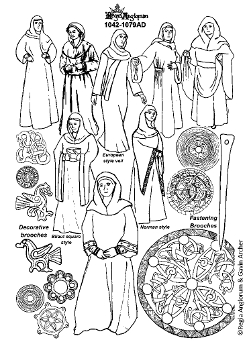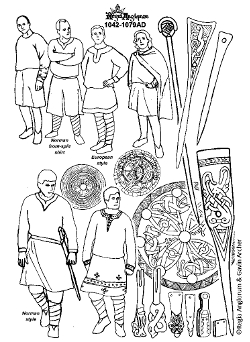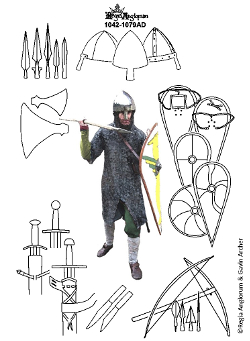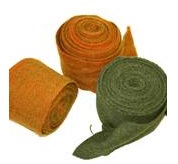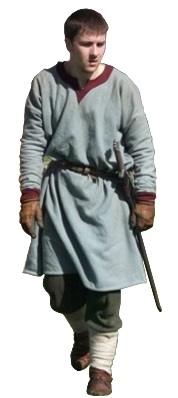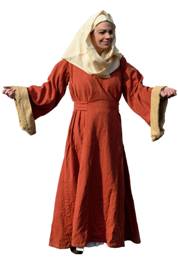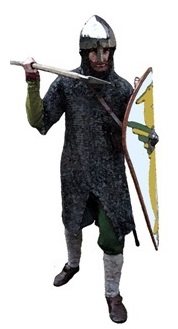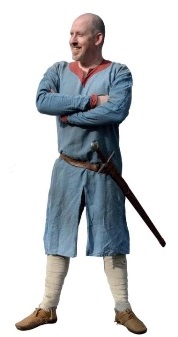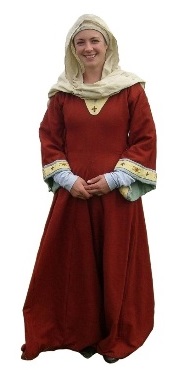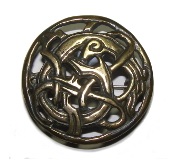Authenticity Officer’s Photo Guide – Examples of Authentic Kit
The Examples of Authentic Kit is a gallery of good examples of authentic kit, and can be used by members as a guide for what to aspire to. However, it is also an open competition amongst the membership, where they can submit photographs of themselves in kit – with examples of the most authentic kit being shown here.
All Periods
All Periods793 - 899
793 - 899900 - 979
900 - 979980 - 1041
980 - 10411042 - 1079
1042 - 10791080 - 1179
1080 - 11791180 - 1215
1180 - 1215The Normans come to England. The Battle of Hastings.
1042 saw the adoption of Norman and French fashions into England. As Christians, all women cover their hair when outside the home. In England the long scarf veil is worn just as it is across Europe. It is worn loosely draped over the head and wrapped around the shoulders whilst leaving the neck showing. The hood like wimple is still worn, but is becoming less fashionable.
Most women wear a linen shift. There are a number of different garments that can be worn over this. Most common is an ankle length woollen dress with either sleeves that are loose and cut slightly shorter to expose the cuff of the shift underneath or else with tight sleeves to the wrist. Neck-holes are either round or oval, and can have a keyhole opening. Decoration, in the form of facings, silk strips, embroidery or tablet weave, can be applied to the cuffs. Tied belts of simple braid or cloth can be worn, but never belts of leather.
Sometimes a ‘mantle’ can be worn, which is a woollen conical over garment that can be worn belted with a wide cloth sash. Loose sleeved dresses and mantles are never worn together.
Another option being adopted by rich women is the European fashion of wearing dresses with extremely wide cuffs known as bliaut sleeves. Some of these bliaut dresses are more fitted with sewn in gathering patches being added to their sides.
Shoes are of the simple, two-part turn shoe construction and are usually low, coming to below the ankle.
Jewellery is usually of either copper-alloy or pewter, small and for decoration only. Some silver jewellery is still worn, especially the fashionable silver penny brooches with their cross side always showing. Larger brooches and pins are still used to secure garments. Romance and Urnes art styles are popular.
The primary garment is the tunic. Its skirt comes to the knee cap or just above and it’s always worn tight to the forearm and wrist. Neck-holes are either round, oval or square, and often have a keyhole opening. Decoration, in the form of facings, embroidery, silk strips or tablet weave, can be applied to the cuffs and neck-hole. Embroidery is sometimes applied to the tunic’s skirt but never around its hem. Tunics are usually made from wool but can also be from linen.
Some European styles of tunic are becoming more popular with the fashionably rich. This includes tunics with a wider neck-hole facing and applied facing to the hem of the tunic’s skirt. The Norman style of split front and rear shirt is also growing in popularity.
Belts can be made from either braided wool or from a leather strap. They can be simply tied or else closed by a buckle of bone, iron or copper-alloy. Belts sometimes have strap-ends attached.
For warmth a cloak can be worn, clasped on the right-hand shoulder by ties or a large disc brooch or pin.
Leg coverings, if worn at all, should be tight to the leg and are usually hose and braies or more rarely trousers. Leg wraps can also be worn. These are long strips of 10cm wide woollen cloth worn wound about the lower leg from the ankle to the knee.
Shoes are of the simple, two-part turn shoe construction and are usually low, coming to below the ankle.
Jewellery is usually of copper-alloy or pewter although some silver is still used. Romance and Urnes styles are common.
This period sees the adoption of European military styles of combat especially after the Norman Conquest of 1066. Weapons and armour are generally plain and utilitarian being mass produced in the industrialised towns.
The conical iron helmet is worn by all warriors. The European kite shield rapidly becomes the dominant shield shape, although the traditional round shield continues to be used by some. Mail shirts are worn by most warriors. Generally they come to the elbow and to mid-thigh. The rich however now wear the haulberk style, a long mail shirt coming to the knees, split front and back and with an integral coif.
Warriors carry into battle 1 or 2 javelins to throw and a spear to use one-handed and overarm in combat. Additional weapons could include a seax, a large single edged knife; a simple hand axe; or a sword. Swords are generally plain and carried by most warriors. The seax was carried by the English both as a status symbol and as a weapon of last resort. Dane Axes are carried by some, a large axe wielded in both hands and deployed to stop mounted warriors.
Before the Battle of Hastings in AD1066 the English still mainly fight on foot and only use archery in siege warfare. After the Norman Conquest both archery and mounted combat become common. Most arrows are bodkins, designed to pierce mail-shirts.
Many men wear leg bindings wrapped around their lower legs. They average 9cm wide, have a natural selvage and are primarily woven in a twill to give them more stretch.
By Liz DabornHe wears a woad dyed tunic with a round keyhole neck and long rucked sleeves. At his waist he carries a sword.
AdamThis Lady is wearing the very fashionable European bliaut style of dress. It is gathered at the waist by the use of cloth panels and has large 'Norman' style sleeves.
KatWearing a mail hauberk, with a skirt split front and back and an integral mail coif. His shield carries a zoomorphic design and his sword scabbard passes through and lies under his mail shirt.
RogerThis warriors is shown wearing his Norman style front and back split linen shirt. Shirts are only usually seen while performing manual labour or worn under a mail shirt.
GavinAn aristocratic women wearing a deep madder dyed dress with its wide sleeves cut short to show the cuffs of the linen undershift beneath. The dress is decorated with embroidered Christian cross motifs.
Steph